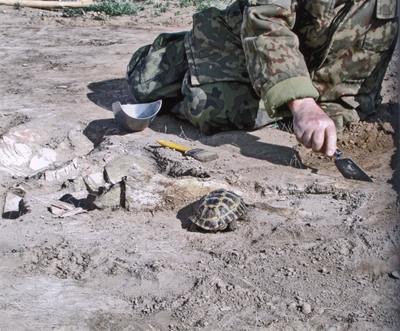The Citadel of AK9
Within this swathe of territory, we excavated in all some 5,920 m2, of which 4,932 belong to the citadel (including the towers) and 988 to the extra-moenia area; that is, two trenches behind the E and S walls (148 m2 ) and a vast area to the S e (840 m2), inside which several structures were uncovered (kilns and furnaces, fireplaces, graves plastered and reinforced with bricks, simple graves and bell graves built in the sand, etc.) and very little evidence of manufäctures. Indeed, just two glasses and one complete bowl and several - but by no means numerous - pottery fragments. The whole gave the idea of an atelier, probably linked to the extraction of clay for the making of bricks. However, this sector will have to be further investigated with greater attention. The remaining area under investigation is covered by sand and full of fragments of manufacture (large containers, table and kitchen pottery, mortars, pestles etc.) which are typical of an urban settlement. In order to complete this picture, we still have to identify the only necropolis which up to now we have failed to find in the small areas from which dunes have been removed to the W and NW of the citadel, where many pottery fragments have been found. It is probable that the necropolis is situated further away from the urban centre than we have excavated up to now, or perhaps it is submerged by the consistent sand formations which surround it. However, given its proximity and interrelated documentation, I would not exclude the possibility that a single necropolis exists för both AK9 and AK1, since the AK1 necropolis is larger in area than we had thought, with its principal axis oriented from SE to NW, in the direction of AK9.
An Overview
At first sight, AK9 presents itself as a fortified citadel in the shape of an irregular parallelogram, surrounded by thick walls, full of habitations which are grouped around a "square palace" situated at the centre of the northern sector.
Let us observe the ruined remains of what were once the walls, reduced to a little less than one metre in height where conditions were more favourable, that is in the centre of the citadel. Externally, these traces grow fainter until they disappear almost completely at the NE and NW corners, where only a few isolated traces 2-5cm in height remain to show that, many centuries ago, there were habitations. In the areas which have undergone the greatest depredations by external agents, only a few remains of the most ancient walls remain. Elsewhere, above all near the socalled "square palace", we can note the superimposition of diverse architectonic constructions which document restoration, extension or restructuring work on the habitations or warehouses, on fortifications, or change of use.
In order to understand what actually happened and to arrive at a reading of this complex on a concrete and practical basis, I believe it is necessary to take into consideration some old settlements constructed in clay which still exist in the Near East and Central Asia and which represent the last examples of a technique which has remained unaltered and self-suffcient throughout thousands of years.
(ibid., p. 45-48)
Source: Rossi Osmida, G.: Adji Kui Oasis. Vol.I: The Citadel of the Figurines.Venice: Il Punto Edizioni 2007.



